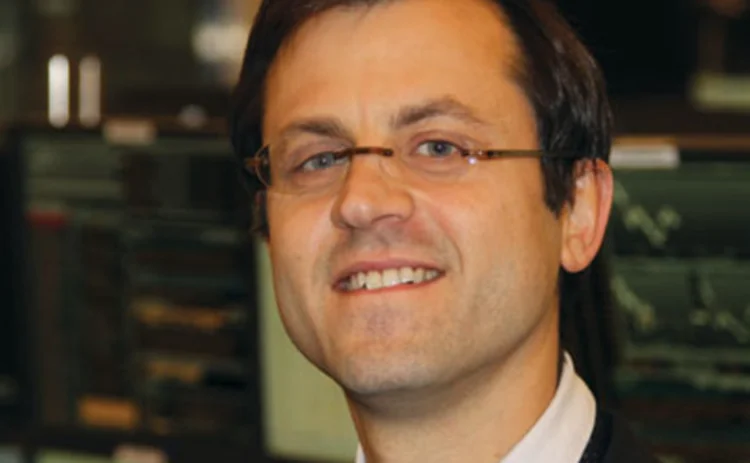
Quant of the year: Pierre Henry-Labordère, Société Générale

Mathematical models have always had their detractors, who view them as black boxes and their creators as blinkered eggheads, but this suspicion is now shaping new bank capital rules – with regulators talking openly about their attempts to reduce the industry’s reliance on models – and is even infecting the quant profession’s view of itself. Abstract maths has isolated the discipline from the real world, the argument goes, and the subject should take a more humble approach (Risk25 July 2012, pages 73-77).
Not everyone feels the same way. Risk’s quant of the year, Pierre Henry-Labordère, a member of the global markets quantitative analytics team at Société Générale Corporate & Investment Banking (SG CIB) in Paris, is a great believer in the power of mathematics.
“It’s a pity that quants in the industry tend to think only in terms of stochastic calculus, or just use the Itô lemma or other traditional methods. It’s much better to have a huge tool box you can delve in to. That way, when you try to solve a problem, you can use whatever you want – differential geometry, quantum physics, anything,” he says.
Known for his use – some say overuse – of high-powered maths from multiple branches of the subject, Henry-Labordère published two articles in Risk last year pioneering the use of a simulation technique that has its roots in such arcana as so-called optimal transport theory and the solution of non-linear stochastic differential equations (SDEs). But he did so with his sights fixed on practical, real-world problems – the computation costs in calibration to vanilla options, and credit valuation adjustment (CVA).
Optimal transport looks at how to find a ‘path’ from one distribution to another, while minimising the value of a cost function. That may sound abstract, but it has a more prosaic application in the calibration of models that use both local and stochastic volatility – how to evolve a risk-neutral distribution, as implied by vanilla options prices, from one maturity to another while excluding arbitrage.
It’s not complicated, actually. Using Malliavin is no harder than using the Itô lemma or the Girsanov theorem
This is equivalent to solving a non-linear SDE – that is, finding a process for which the driving functions themselves depend on the shape of its probability distribution at any given time. So, for instance, the volatility could be more likely to increase as the distribution widens.
In Being particular about calibration, co-written with his then-colleague Julien Guyon, now working at Bloomberg, Henry-Labordère solved this problem in a computationally lean manner (Risk January 2012, pages 88-93). Normally, the focus would be on solving discrete versions of corresponding partial differential equations (PDEs) – as in the work of last year’s winners, Danske Bank’s Jesper Andreasen and Brian Huge – but once multiple noise sources are included, this approach becomes computationally intense. Quants refer to this as the ‘curse of dimensionality’.
Henry-Labordère and Guyon kept the computational burden light by using a simulation approach known as the particle method. It has been applied in other branches of science, but as with much of Henry-Labordère’s work, the primary inspiration is physics. In what is known as the mean-field approximation, huge numbers of interacting particles are modelled as a continuous force field. Henry-Labordère and Guyon turned this on its head and split their full, non-linear equation into ‘particles’ – that is, paths in a Monte Carlo simulation.
The clever part was doing this in a way that preserves the dependence on the distribution – by using a particular discretisation of it. “In spirit, it’s quite like our random grids approach, in that it is a discrete model,” says Danske’s Andreasen. “But being a pure Monte Carlo approach, it doesn’t suffer from the curse of dimensionality, and will make calibration practically feasible when you have many noise sources. It’s a pretty neat idea. I wish I’d thought of it, actually.”
The article illustrates this by applying the method to a so-called hybrid model – one that considers stochastic interest rates as well as the underlying asset – where its performance starts to come into its own relative to a PDE solution or nested Monte Carlo. The method is currently applied at SG CIB to the bank’s own hybrid models for its equity derivatives business.
Société Générale is famous as an equity derivatives house, and not surprisingly its quant team has tended to work primarily on this asset class. Henry-Labordère’s second article, Cutting CVA’s complexity, is an exception, tackling what is arguably the biggest computational problem facing quants (Risk July 2012, pages 67-73).
It made an impression. “It’s an exciting approach, potentially really important for reducing computational cost,” says Ersel Korusoy, a Singapore-based Royal Bank of Scotland CVA trader.
The approach in question is an extension of the particle method, with a discrete random variable overlaid to model default. This borrows a trick from evolutionary biology, allowing the particles to ‘die’ – representing default – and to produce ‘offspring’ equating to recovery values. It’s a simple enough adjustment conceptually, but the parallel algorithm to account for default – and the fact that only positive mark-to-market exposures are relevant from a CVA perspective – make the mathematics more complex.
Only users who have a paid subscription or are part of a corporate subscription are able to print or copy content.
To access these options, along with all other subscription benefits, please contact info@risk.net or view our subscription options here: http://subscriptions.risk.net/subscribe
You are currently unable to print this content. Please contact info@risk.net to find out more.
You are currently unable to copy this content. Please contact info@risk.net to find out more.
Copyright Infopro Digital Limited. All rights reserved.
You may share this content using our article tools. Printing this content is for the sole use of the Authorised User (named subscriber), as outlined in our terms and conditions - https://www.infopro-insight.com/terms-conditions/insight-subscriptions/
If you would like to purchase additional rights please email info@risk.net
Copyright Infopro Digital Limited. All rights reserved.
You may share this content using our article tools. Copying this content is for the sole use of the Authorised User (named subscriber), as outlined in our terms and conditions - https://www.infopro-insight.com/terms-conditions/insight-subscriptions/
If you would like to purchase additional rights please email info@risk.net
More on Awards
Joining the dots: banks leverage tech advancements for the future of regulatory reporting
The continued evolution of regulatory frameworks is creating mounting challenges for capital markets firms in achieving comprehensive and cost-effectiveawa compliance reporting. Regnology discusses how firms are starting to use a synthesis of emerging…
Markets Technology Awards 2024 winners' review
Vendors spy opportunity in demystifying and democratising – opening up markets and methods to new users
Derivatives house of the year: JP Morgan
Risk Awards 2024: Response to regional banking crisis went far beyond First Republic
Risk Awards 2024: The winners
JP Morgan wins derivatives house, lifetime award for El Karoui, Barclays wins rates
Best product for capital markets: Murex
Asia Risk Awards 2023
Technology vendor of the year: Murex
Asia Risk Awards 2023
Best structured products support system: Murex
Asia Risk Awards 2023
Energy Risk Asia Awards 2023: the winners
Winning firms demonstrate resiliency and robust risk management amid testing times







